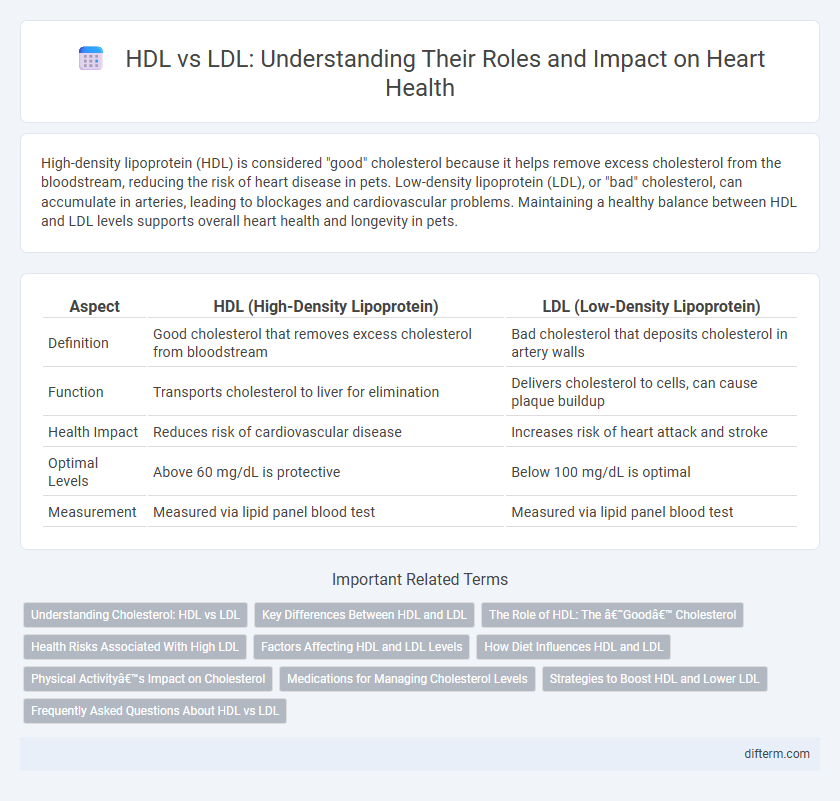High-density lipoprotein (HDL) is considered "good" cholesterol because it helps remove excess cholesterol from the bloodstream, reducing the risk of heart disease in pets. Low-density lipoprotein (LDL), or "bad" cholesterol, can accumulate in arteries, leading to blockages and cardiovascular problems. Maintaining a healthy balance between HDL and LDL levels supports overall heart health and longevity in pets.
Table of Comparison
| Aspect | HDL (High-Density Lipoprotein) | LDL (Low-Density Lipoprotein) |
|---|---|---|
| Definition | Good cholesterol that removes excess cholesterol from bloodstream | Bad cholesterol that deposits cholesterol in artery walls |
| Function | Transports cholesterol to liver for elimination | Delivers cholesterol to cells, can cause plaque buildup |
| Health Impact | Reduces risk of cardiovascular disease | Increases risk of heart attack and stroke |
| Optimal Levels | Above 60 mg/dL is protective | Below 100 mg/dL is optimal |
| Measurement | Measured via lipid panel blood test | Measured via lipid panel blood test |
Understanding Cholesterol: HDL vs LDL
HDL (high-density lipoprotein) and LDL (low-density lipoprotein) are crucial cholesterol types impacting cardiovascular health. HDL, known as "good cholesterol," helps remove excess cholesterol from the bloodstream, reducing the risk of heart disease. In contrast, LDL or "bad cholesterol" deposits cholesterol in artery walls, leading to plaque buildup and increased risk of atherosclerosis and heart attacks.
Key Differences Between HDL and LDL
HDL (High-Density Lipoprotein) is known as "good cholesterol" because it helps remove excess cholesterol from the bloodstream and transports it to the liver for excretion, reducing the risk of heart disease. LDL (Low-Density Lipoprotein), often called "bad cholesterol," carries cholesterol to cells but can lead to plaque buildup in arterial walls, increasing the risk of atherosclerosis and cardiovascular events. Key differences include their density, role in cholesterol transport, and impact on cardiovascular health, with higher HDL levels associated with protective effects and elevated LDL levels linked to heart disease.
The Role of HDL: The ‘Good’ Cholesterol
HDL, known as the 'good' cholesterol, plays a crucial role in cardiovascular health by transporting excess cholesterol from the arteries to the liver for excretion, reducing plaque buildup and lowering heart disease risk. Higher HDL levels are associated with decreased incidence of atherosclerosis and stroke due to its anti-inflammatory and antioxidant properties. Maintaining optimal HDL cholesterol through regular exercise, healthy diet, and avoiding smoking supports improved lipid profiles and overall heart function.
Health Risks Associated With High LDL
High levels of low-density lipoprotein (LDL) cholesterol significantly increase the risk of atherosclerosis, leading to heart disease and stroke. Elevated LDL contributes to plaque buildup in arteries, restricting blood flow and causing inflammation. Monitoring and managing LDL cholesterol is crucial to reduce cardiovascular events and improve long-term health outcomes.
Factors Affecting HDL and LDL Levels
Diet rich in saturated fats and trans fats elevates LDL cholesterol, increasing cardiovascular risk, while intake of omega-3 fatty acids and soluble fiber boosts HDL levels, promoting heart health. Physical activity and weight management play crucial roles, as regular exercise raises HDL and reduces LDL concentrations. Genetic predispositions and certain medications also influence individual cholesterol profiles, necessitating personalized medical approaches for optimal lipid control.
How Diet Influences HDL and LDL
Consuming foods rich in unsaturated fats, such as olive oil, nuts, and fatty fish, raises HDL (high-density lipoprotein) levels, which help remove cholesterol from arteries and reduce cardiovascular risk. Diets high in saturated fats, trans fats, and refined sugars increase LDL (low-density lipoprotein) cholesterol, promoting plaque buildup and heart disease. Increasing intake of fiber-rich fruits, vegetables, and whole grains supports healthier lipid profiles by lowering LDL and enhancing HDL function.
Physical Activity’s Impact on Cholesterol
Physical activity significantly raises HDL (high-density lipoprotein) cholesterol, which helps remove LDL (low-density lipoprotein) cholesterol, known for clogging arteries. Regular exercise, such as brisk walking or cycling for at least 150 minutes per week, improves lipid profiles by reducing LDL levels and increasing protective HDL particles. Enhanced HDL function through physical activity supports cardiovascular health by promoting cholesterol transport away from blood vessels.
Medications for Managing Cholesterol Levels
Medications for managing cholesterol levels primarily target reducing low-density lipoprotein (LDL) cholesterol to lower the risk of cardiovascular disease. Statins, the most common prescribed drugs, effectively decrease LDL by inhibiting HMG-CoA reductase, an enzyme crucial for cholesterol synthesis. Emerging therapies like PCSK9 inhibitors and bile acid sequestrants also contribute to lowering LDL, while niacin and fibrates can help increase high-density lipoprotein (HDL) levels to improve lipid profiles.
Strategies to Boost HDL and Lower LDL
Increasing HDL cholesterol involves regular aerobic exercise, consuming healthy fats such as omega-3 fatty acids found in fish and flaxseeds, and avoiding trans fats. Reducing LDL cholesterol can be achieved by limiting saturated fat intake, incorporating soluble fiber-rich foods like oats and legumes, and considering plant sterols or stanols supplementation. Medication such as statins may be prescribed for individuals with high LDL levels that do not respond to lifestyle changes alone.
Frequently Asked Questions About HDL vs LDL
HDL (high-density lipoprotein) is known as "good" cholesterol because it helps remove excess cholesterol from the bloodstream, reducing the risk of heart disease, while LDL (low-density lipoprotein) is considered "bad" cholesterol as it contributes to plaque buildup in arteries. Frequently asked questions about HDL vs LDL often address optimal cholesterol levels, with HDL levels above 60 mg/dL being protective and LDL levels below 100 mg/dL recommended to minimize cardiovascular risk. Understanding the balance between HDL and LDL is crucial for managing heart health and preventing atherosclerosis.
HDL vs LDL Infographic

 difterm.com
difterm.com